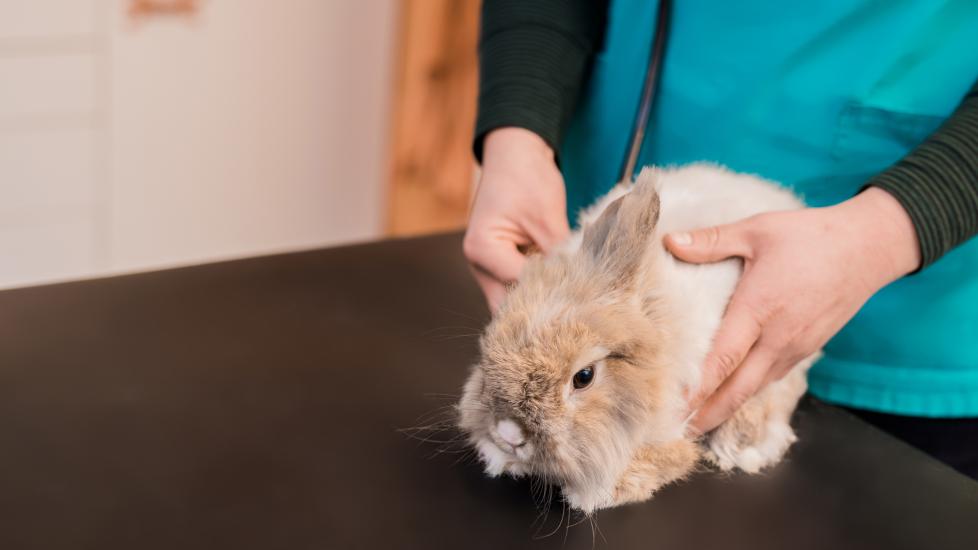Flystrike in Rabbits
DjelicS/iStock via Getty Images
What Is Flystrike in Rabbits?
Flystrike, also known as myiasis, is a serious condition affecting both wild and pet rabbits. It's caused by a fly larvae (maggot) infestation.
Flystrike in rabbits often occurs on inflamed or damaged skin near body openings, such as near the genitals or open wounds. Outdoor rabbits are more susceptible due to their increased exposure to flies.
Pet parents should promptly seek treatment for any suspicion of flystrike in their rabbit. Flystrike can cause issues with a rabbit's flesh within 24 hours and can quickly become fatal if not treated appropriately.
Symptoms of Flystrike in Rabbits
-
Lethargy
-
Decreased appetite
-
Decreased grooming
-
Foul odor
-
Infected wounds
-
Presence of fly larvae (maggots)
-
Red, swollen, or ulcerated skin
Causes of Flystrike in Rabbits
Flies are attracted to open wounds, dirty areas, and moist conditions where they lay eggs and complete their life cycle. Once the eggs are laid, the developing larvae hatch at the site and cause further tissue damage. Fly larvae are destructive while feeding and may tunnel or burrow through a rabbit’s skin, further damaging organs and tissue.
Underlying diseases or conditions that would cause sickness, reduce movement, or decrease grooming in a rabbit could easily attract flies, leading to flystrike.
Common culprits that attract flystrike include:
-
Feces or urine scald (baldness and red, irritated skin near the genital area due to urine leakage or dribbling)
-
Obesity
-
Dental disease
-
Arthritic conditions
-
Outdoor housing
-
Soiled bedding
-
Large skin folds (dewlaps)
-
Warm weather
-
Abscesses
-
Urinary tract infections or stones causing dribbling urine
Flies that can cause flystrike include:
-
Blow flies (bluebottle or greenbottle flies)
-
Bot flies
-
Cuterebra
-
Gadflies
-
Flesh flies
-
Fox maggot
How Veterinarians Diagnose Flystrike in Rabbits
Veterinarians can usually diagnose flystrike through a physical exam, although early stages might not yet be obvious. They'll also inquire about your rabbit's outdoor exposure, wounds, and overall care (housing, diet, and activities).
Routine blood work might be necessary to assess overall health and hydration.
Treatment of Flystrike in Rabbits
Treatment for rabbit flystrike is a multistep process and includes:
-
Maggot Removal—Manual removal of maggots is the primary method of treatment for flystrike. This is a painful procedure, and rabbits must be sedated for thorough flushing and removal. Medications such as ivermectin or nitenpyram may be useful during this procedure to aid in killing the maggots.
-
Supportive Care—Rabbits are sensitive creatures and require extensive supportive care and hospitalization during the treatment and recovery period, including:
-
Fluids to address dehydration
-
Heat support to maintain body temperature
-
Nutrition support to ensure proper nourishment such as Oxbow® Critical Care®
-
-
Antibiotics—Most flystrike wounds have secondary bacterial infections, so many veterinarians will start rabbits on an antibiotic such as trimethoprim sulfa (TMS) until culture and sensitivity results are available.
-
Pain Management—Pain medication (NSAIDs like meloxicam) is crucial for comfort and encouraging the rabbit to move and eat normally.
-
Wound Care and Cleaning—Removal of feces, urine, and matted fur is essential to promote healing.
Recovery and Management of Flystrike in Rabbits
Prognosis for flystrike in rabbits is typically good with appropriate and early care. However, if a rabbit is showing signs of the larvae affecting the nervous system, the prognosis is worse.
Rabbits suffering from flystrike should be kept indoors and checked often until full recovery, with multiple inspections of the treated area daily. Any necessary changes in care should be made to prevent future fly larval infestations.
The best way to treat flystrike in rabbits is to prevent it from happening. Rabbits should always be housed in clean and dry locations and pet parents should check daily for any wounds, matted hair, or fecal accumulation.
Pet parents should always practice good hygiene with their rabbit, including regular bedding changes and clean food and water bowls. Work with your veterinarian to address any underlying health conditions that may predispose your rabbit to flystrike.
Unfortunately, rabbits with severe cases of flystrike may initially survive treatments but ultimately succumb to secondary infection, dehydration, or shock. Humane euthanasia may be discussed by your vet in severe cases.
Flystrike in Rabbits FAQs
How do I know if my rabbit has flystrike?
Rabbits are more susceptible to flystrike if they have open wounds, or dirty or matted fur. The most obvious sign of flystrike is the presence of maggots within wounds.
How do you get rid of flystrike in rabbits?
Because rabbits require sedation to fully flush any open wounds to remove all parts of the maggots, only a veterinarian should treat flystrike.
Is flystrike common in indoor rabbits?
Flystrike is more common in outdoor rabbits, but any rabbit that has a wound or moist or matted fur is susceptible.
How much does it cost to treat flystrike in rabbits?
Early cases of flystrike are not expensive to treat and require little supportive care. Severe and moderate cases will require hospitalization and additional expenses.
Is flystrike fatal in rabbits?
Flystrike can develop within 24 hours and can quickly become fatal if not treated appropriately.
What do flystrike eggs look like?
Every fly species lays slightly different-looking eggs. Some may look like a grain of rice. They typically hatch within 24 hours and often look like small white worms.
References
Pavlovsky DVM, DABVP (Canine & Feline), Gene. Veterinary Information Network, Inc. Myiasis in Rabbits (Exotic Pets). 2023.
